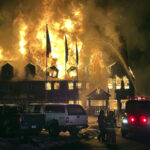Fitch reports leaner and more transparent brokers are better equipped to deal with changing market conditions
Taken as a group, the nation’s largest public insurance brokers did better in 2007 than 2006, although the continuing soft market will make it harder for them to improve a lot on the 2007 performance in 2008, according to ratings analysts at Fitch.
Fitch rates the outlook of the insurance broker industry for 2007-2008 as stable.
“While industry profitability and operating margins will not return to levels reported in the early 2000s, broker operating performance in 2007 will be modestly better than 2006, largely due to the larger brokers adapting to the elimination of contingent commissions,” said James B. Auden, head of the property/casualty sector for Fitch.
Leaner and more transparent as a result of their expense cuts and restructurings following the erosion of contingent commission income, these brokers are “better equipped to deal with the challenges of deteriorating insurance market conditions and intense competition,” he said.
The largest brokers forfeited considerable income from contingent commissions beginning in 2004 when the New York attorney general began attacking them.
In terms of reported revenue growth for year-to-date 2007, Fitch reported the average growth of the top six brokers to be 13 percent, with Marsh & McLennan (MMC) at 3 percent, Aon and Willis both at 7 percent. Both Willis and Aon have done better (4 percent) in organic growth than Marsh, with 0 percent.
For the first nine months of 2007, the top six publicly traded brokers reported consolidated operating income up by an average of 14 percent, according to Fitch. All, except MMC, have reported improvement in 2007.
2008 Outlook
For 2008, Auden said Fitch expects overall industry profitability for these brokers “to be flat to modestly improved.”
He said “the accelerating pace of insurance rate decreases will challenge brokers to grow organically, and make it difficult for brokers to improve margins, especially since several of the larger brokers have already gone through several rounds of expense reductions over the past several years.”
Despite the challenges they have faced and will face, overall the larger brokers “continue to possess qualities that are consistent with investment-grade ratings,” according Auden.
Fitch estimates that based on 2006 revenues, the top five global brokers — Marsh & McLennan; Aon; Willis Group Holdings; Arthur J. Gallagher; Wells Fargo — control about 70 to 75 percent of the overall insurance brokerage market, and that the top 10 have about 86 percent market share. Marsh leads with 35 percent of the total market, followed by Aon with 22 percent and Willis with 8 percent.
The top three — MMC, Aon and Willis — each received solid debt ratings along with stable outlook ratings from Fitch. Fitch’s senior debt and outlook ratings for the biggest three brokers are: Aon, BBB+ and Stable; MMC, BBB and Stable; and Willis, BBB and Stable.
But there are different stories behind the ratings.
Of the three, Aon is rated the highest, reflecting Fitch’s view of the company’s “progress in developing a new business model that is less reliant on contingent commission income,” said Gretchen K. Roetzer, Fitch’s analyst for Aon.
“Aon continues to demonstrate its ability to retain clients and grow new business while improving profitability,” she said.
Gregory W. Dickerson focused on Willis and MMC in his report.
In the case of Willis, Fitch is impressed with “the company’s superior operating performance, excellent operating margins relative to peers, strong cash flow, established market position, and management experience,” he said.
The positives at Willis are somewhat offset by concerns related to debts of $600 million in March and then another $1 billion in November, much of which was used to repurchase common shares. “As a result, Fitch believes that Willis’ key credit fundamentals will continue to worsen in the near to medium term,” said Dickerson.
MMC Instability
MMC’s rating of stable — a rating Fitch raised from negative in June — is less certain than the others due to “continuing instability in its insurance brokerage operations,” according to Dickerson.
Of the biggest brokers, MMC has made the least progress in overcoming the loss of contingent commission income and franchise value. He said Fitch remains concerned that MMC’s insurance segment performance “continues to lag that of its closest peers.”
But Dickerson also said MMC remains a “very competitive” and valuable enterprise given its strong and diversified group of businesses.
The Fitch analyst suggested that the worst could be over for MMC. “Most of the bad news has come out — but we’re watching very carefully,” he said.
Fitch also sees smaller or regional brokers, many of which still accept contingent commissions, in good shape. “Regional brokers are doing better than the large national brokers and will continue to post higher margins,” Auden said.
Fitch noted that two formerly publicly traded brokers, HUB International Limited and USI Holdings Corp., were both acquired by private equity investors during 2007 and that MMC has also been widely rumored as a potential target to be taken private.
Top 10 Insurance Brokers (as ranked by 2006 brokerage revenues)
| 1 | Marsh & McLennan | $10.5 billion |
| 2 | Aon | $6.7 billion |
| 3 | Willis Group Holdings | $2.3 billion |
| 4 | Arthur J. Gallagher | $1.4 billion |
| 5 | Wells Fargo | $1.0 billion |
| 6 | Brown & Brown | $900 million |
| 7 | Jardine Lloyd Thompson | $800 million |
| 8 | BB&T Insurance Services | $800 million |
| 9 | Hilb Rogal & Hobbs | $700 million |
| 10 | Lockton Cos. | $700 million |
Source: Fitch Ratings
Was this article valuable?
Here are more articles you may enjoy.


 Owner of Historic Minnesota Resort Charged With Arson, Insurance Fraud
Owner of Historic Minnesota Resort Charged With Arson, Insurance Fraud  Baldwin Group to Buy CAC Group for About $1B in Cash and Stock
Baldwin Group to Buy CAC Group for About $1B in Cash and Stock  Acrisure to Buy MGA Vave From Canopius
Acrisure to Buy MGA Vave From Canopius  Viewpoint: Agentic AI Is Coming to Insurance Industry – Much Faster Than You Think
Viewpoint: Agentic AI Is Coming to Insurance Industry – Much Faster Than You Think 


